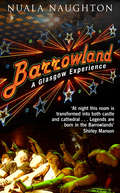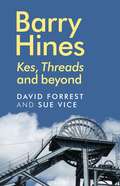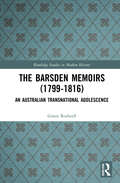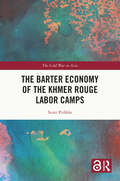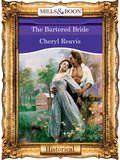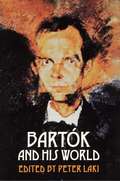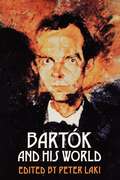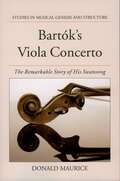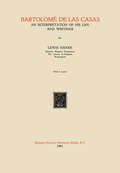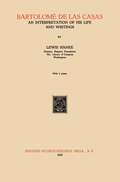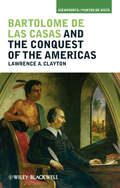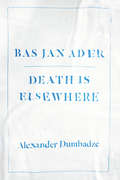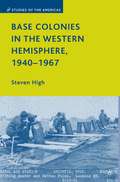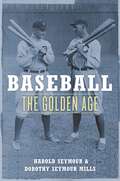- Table View
- List View
Barrowland: A Glasgow Experience
by Nuala NaughtonBarrowland: A Glasgow Experience charts the amazing resurrection of the legendary rock concert venue from its humble beginnings as a popular Glasgow dance hall through its commercial decline in the 1960s and beyond until it was reinvented in the early ’80s as a concert venue that remains feted by fans and artistes alike.This book documents many of the gigs to have been held in the Barrowland, complete with reminiscences about backstage shenanigans and fascinating contributions from many of the musicians who have played there, as well as from fans who cherish memories of unforgettable concerts.Packed with interviews from the stars of popular music past and present, Barrowland: A Glasgow Experience allows readers to take a trip down memory lane and remember their favourite gigs at the world-famous venue in Glasgow’s East End.
Barry Hines: <i>Kes</i>, <i>Threads</i> and beyond
by David Forrest Sue ViceThis is the first full-length critical study of the work of Barry Hines, best know as the author of A Kestrel for a Knave
Barry Hines: <i>Kes</i>, <i>Threads</i> and beyond
by David Forrest Sue ViceBarry Hines’s novel A Kestrel for a Knave, adapted for the screen as Kes, is one of the best-known and well-loved novels of the post-war period, while his screenplay for the television drama Threads is central to a Cold War-era vision of nuclear attack. But Hines published a further eight novels and nine screenplays between the 1960s and 1990s, as well as writing eleven other works which remain unpublished and unperformed. This study examines the entirety of Hines’s work. It argues that he used a great variety of aesthetic forms to represent the lives of working-class people in Britain during the 1960s, 1970s, 1980s and into the post-industrial conclusion of the twentieth century. It also makes the case that, as well as his literary flair for poetic realism, Hines’s authorial contributions to the films of his novels show the profoundly collaborative nature of these works.
The Barsden Memoirs: An Australian Transnational Adolescence (Routledge Studies in Modern History)
by Grant RodwellCovering the life of Josephus Henry Barsden from his birth in 1799 through his childhood to 16 years of age, the Barsden memoirs describe events from a Sussex smugglers’ inn, a convict ship to the colony of New South Wales, sealing and whaling expeditions to Van Diemen’s Land, and Barsden’s participation in a Tahitian civil war. The author assesses the value of memoirs, and of these memoirs in particular to students of history in respect to the transnational paradigm. He tests the historicity and veracity of their contents, and provides an engaging exegesis and graphical supplement of its contents. Of central importance is Barsden’s account of the Battle of Fe’i Pi, which was in many respects the Pacific’s equivalent to the contemporaneous Battle of Waterloo, such was its lasting impact on Pacific geopolitics. This was no ordinary childhood, and poses many questions about a transnational adolescent’s impact on major events. A fascinating read for scholars and students of Australian, Pacific, and British Colonial History, written with academic rigour but accessible to non-specialists.
The Barsden Memoirs: An Australian Transnational Adolescence (Routledge Studies in Modern History)
by Grant RodwellCovering the life of Josephus Henry Barsden from his birth in 1799 through his childhood to 16 years of age, the Barsden memoirs describe events from a Sussex smugglers’ inn, a convict ship to the colony of New South Wales, sealing and whaling expeditions to Van Diemen’s Land, and Barsden’s participation in a Tahitian civil war. The author assesses the value of memoirs, and of these memoirs in particular to students of history in respect to the transnational paradigm. He tests the historicity and veracity of their contents, and provides an engaging exegesis and graphical supplement of its contents. Of central importance is Barsden’s account of the Battle of Fe’i Pi, which was in many respects the Pacific’s equivalent to the contemporaneous Battle of Waterloo, such was its lasting impact on Pacific geopolitics. This was no ordinary childhood, and poses many questions about a transnational adolescent’s impact on major events. A fascinating read for scholars and students of Australian, Pacific, and British Colonial History, written with academic rigour but accessible to non-specialists.
The Barter Economy of the Khmer Rouge Labor Camps (The Cold War in Asia)
by Scott PribblePribble investigates the barter economies that developed in many of the labor camps established under the Khmer Rouge in Cambodia. When the Khmer Rouge abolished currency and markets in 1975, starving Cambodians created underground exchanges in labor camps throughout the country, bartering luxury items for food and other necessities, while simultaneously undermining the regime’s ideological goals of eliminating any traces of capitalism in Democratic Kampuchea. Pribble asserts three key points about the barter economy in the Khmer Rouge labor camps. First, the underground exchanges in Democratic Kampuchea provided food and medicine for desperate people subsisting under a totalitarian regime, saving the lives of countless Cambodians. Second, bartering was the riskiest way to obtain food because it was dependent upon the discretion of two or more individuals from different social classes under the threat of violent punishment, thereby altering the social dynamics of the camps. Finally, despite the regime’s extreme efforts to eliminate foreign influence from the country and impose communist ideology on millions of citizens, basic forms of market capitalism and a demand for superfluous luxury goods persisted in labor camps throughout the country. A fascinating study of the human consequences of imposing rigid ideology, that will be of particular interest to scholars and students of political history and Southeast Asian history.
The Barter Economy of the Khmer Rouge Labor Camps (The Cold War in Asia)
by Scott PribblePribble investigates the barter economies that developed in many of the labor camps established under the Khmer Rouge in Cambodia. When the Khmer Rouge abolished currency and markets in 1975, starving Cambodians created underground exchanges in labor camps throughout the country, bartering luxury items for food and other necessities, while simultaneously undermining the regime’s ideological goals of eliminating any traces of capitalism in Democratic Kampuchea. Pribble asserts three key points about the barter economy in the Khmer Rouge labor camps. First, the underground exchanges in Democratic Kampuchea provided food and medicine for desperate people subsisting under a totalitarian regime, saving the lives of countless Cambodians. Second, bartering was the riskiest way to obtain food because it was dependent upon the discretion of two or more individuals from different social classes under the threat of violent punishment, thereby altering the social dynamics of the camps. Finally, despite the regime’s extreme efforts to eliminate foreign influence from the country and impose communist ideology on millions of citizens, basic forms of market capitalism and a demand for superfluous luxury goods persisted in labor camps throughout the country. A fascinating study of the human consequences of imposing rigid ideology, that will be of particular interest to scholars and students of political history and Southeast Asian history.
Bartered Bride: Secret Heiress / Bartered Bride (Mills And Boon Historical Ser.)
by Anne HerriesIndulge your fantasies of delicious Regency Rakes, fierce Viking warriors and rugged Highlanders. Be swept away into a world of intense passion, lavish settings and romance that burns brightly through the centuries
The Bartered Bride (Mills And Boon Vintage 90s Modern Ser.)
by Cheryl Reavis"Do We Marry Or Not, Caroline Holt?"
Barth Reception in Britain
by D. Densil MorganThis is the first book length assessment in English of the impact of Karl Barth's theology in Britain. Beginning with the essays of Adolf Keller and H.R. Mackintosh in the 1920s, it analyses the interplay between Barth's developing thought and different strands of English, Scottish and Welsh church history up to the 1980s. Barth's impact on British perceptions of the German Church Struggle during the 1930s is discussed, along with the ready acceptance that his theology gained among the English Congregationalists, Welsh Nonconformists and theologians of the Church of Scotland. Half forgotten names such as John McConnachie and Nathaniel Micklem are brought to light along with better known representatives of British Barthianism like Daniel T. Jenkins and T.F. Torrance. Barth and the secular theology of the 1960s are assessed, along with the beginnings of the Barthian renaissance linked with Colin Gunton and others during the 1980s. Barth Reception in Britain is a contribution to modern church history as well as the history of doctrine.
Bartók and His World (The Bard Music Festival #50)
by Peter LakiBéla Bartók, who died in New York fifty years ago this September, is one of the most frequently performed twentieth-century composers. He is also the subject of a rapidly growing critical and analytical literature. Bartók was born in Hungary and made his home there for all but his last five years, when he resided in the United States. As a result, many aspects of his life and work have been accessible only to readers of Hungarian. The main goal of this volume is to provide English-speaking audiences with new insights into the life and reception of this musician, especially in Hungary. Part I begins with an essay by Leon Botstein that places Bartók in a large historical and cultural context. László Somfai reports on the catalog of Bartók's works that is currently in progress. Peter Laki shows the extremes of the composer's reception in Hungary, while Tibor Tallián surveys the often mixed reviews from the American years. The essays of Carl Leafstedt and Vera Lampert deal with his librettists Béla Balázs and Melchior Lengyel respectively. David Schneider addresses the artistic relationship between Bartók and Stravinsky. Most of the letters and interviews in Part II concern Bartók's travels and emigration as they reflected on his personal life and artistic evolution. Part III presents early critical assessments of Bartók's work as well as literary and poetic responses to his music and personality.
Bartók and His World (PDF)
by Peter LakiBéla Bartók, who died in New York fifty years ago this September, is one of the most frequently performed twentieth-century composers. He is also the subject of a rapidly growing critical and analytical literature. Bartók was born in Hungary and made his home there for all but his last five years, when he resided in the United States. As a result, many aspects of his life and work have been accessible only to readers of Hungarian. The main goal of this volume is to provide English-speaking audiences with new insights into the life and reception of this musician, especially in Hungary. Part I begins with an essay by Leon Botstein that places Bartók in a large historical and cultural context. László Somfai reports on the catalog of Bartók's works that is currently in progress. Peter Laki shows the extremes of the composer's reception in Hungary, while Tibor Tallián surveys the often mixed reviews from the American years. The essays of Carl Leafstedt and Vera Lampert deal with his librettists Béla Balázs and Melchior Lengyel respectively. David Schneider addresses the artistic relationship between Bartók and Stravinsky. Most of the letters and interviews in Part II concern Bartók's travels and emigration as they reflected on his personal life and artistic evolution. Part III presents early critical assessments of Bartók's work as well as literary and poetic responses to his music and personality.
Bartok's Viola Concerto: The Remarkable Story of His Swansong (Studies In Musical Genesis, Structure, and Interpretation)
by Donald MauriceWhen Bela Bartók died in September of 1945, he left a partially completed viola concerto commissioned by the virtuoso violist William Primrose. Yet, while no definitive version of the work exists, this concerto has become arguably the most-performed viola concerto in the world. The story of how the concerto came to be, from its commissioning by Primrose to its first performance to the several completions that are performed today is told here in Bartók's Viola Concerto:The Remarkable Story of His Swansong. After Bartók's death, his family asked the composer's friend Tibor Serly to look over the sketches of the concerto and to prepare it for publication. While a draft was ready, it took Serly years to assemble the sketches into a complete piece. In 1949, Primrose finally unveiled it, at a premiere performance with the Minneapolis Symphony Orchestra. For almost half a century, the Serly version enjoyed great popularity among the viola community, even while it faced charges of inauthenticity. In the 1990s, several revisions appeared and, in 1995, the composer's son, Peter Bartók, released a revision, opening the way or an intensified debate on the authenticity of the multiple versions. This debate continues as violists and Bartók scholars seek the definitive version of this final work of Hungary's greatest composer. Bartók's Viola Concerto tells the story of the genesis and completion of Bartók's viola concerto, its reception over the second half of the twentieth century, its revisions, and future possibilities.
Bartolomé de las Casas and the Conquest of the Americas (Viewpoints / Puntos De Vista Ser. #15)
by ClaytonThis is a short history of the age of exploration and the conquest of the Americas told through the experience of Bartolomé de las Casas, a Dominican friar who fervently defended the American Indians, and the single most important figure of the period after Columbus. Explores the period known as the Encounter, which was characterized by intensive conflict between Europeans and the people of the Americas following Columbus’s voyages Argues that Las Casas, ‘protector of Indians,' was primarily motivated by Scripture in his crusade for justice and equality for American Indians Draws on the 14 volume Complete Works of Las Casas as a window into his mind and actions Encourages students to understand history through the viewpoint of individuals living it
Bartolomé de las Casas and the Conquest of the Americas
by Lawrence A. ClaytonThis is a short history of the age of exploration and the conquest of the Americas told through the experience of Bartolomé de las Casas, a Dominican friar who fervently defended the American Indians, and the single most important figure of the period after Columbus. Explores the period known as the Encounter, which was characterized by intensive conflict between Europeans and the people of the Americas following Columbus’s voyages Argues that Las Casas, ‘protector of Indians,' was primarily motivated by Scripture in his crusade for justice and equality for American Indians Draws on the 14 volume Complete Works of Las Casas as a window into his mind and actions Encourages students to understand history through the viewpoint of individuals living it
Bas Jan Ader: Death Is Elsewhere
by Alexander DumbadzeOn July 9, 1975, Dutch-born artist Bas Jan Ader set sail from Chatham, Massachusetts, on a thirteen-foot sailboat. He was bound for Falmouth, England, on the second leg of a three-part piece titled In Search of the Miraculous. The damaged boat was found south of the western tip of Ireland nearly a year later. Ader was never seen again. Since his untimely death, Ader has achieved mythic status in the art world as a figure literally willing to die for his art. Considering the artist’s legacy and concise oeuvre beyond the romantic and tragic associations that accompany his peculiar end, Alexander Dumbadze resituates Ader’s art and life within the conceptual art world of Los Angeles in the early 1970s and offers a nuanced argument about artistic subjectivity that explains Ader’s tremendous relevance to contemporary art. Bas Jan Ader blends biography, theoretical reflection, and archival research to draw a detailed picture of the world in which Ader’s work was rooted: a vibrant international art scene populated with peers such as Ger van Elk, William Leavitt, and Allen Ruppersberg. Dumbadze looks closely at Ader’s engagement with questions of free will and his ultimate success in creating art untainted by mediation. The first in-depth study of this enigmatic conceptual artist, Bas Jan Ader is a thoughtful reflection on the necessity of the creative act and its inescapable relation to death.
Bas Jan Ader: Death Is Elsewhere
by Alexander DumbadzeOn July 9, 1975, Dutch-born artist Bas Jan Ader set sail from Chatham, Massachusetts, on a thirteen-foot sailboat. He was bound for Falmouth, England, on the second leg of a three-part piece titled In Search of the Miraculous. The damaged boat was found south of the western tip of Ireland nearly a year later. Ader was never seen again. Since his untimely death, Ader has achieved mythic status in the art world as a figure literally willing to die for his art. Considering the artist’s legacy and concise oeuvre beyond the romantic and tragic associations that accompany his peculiar end, Alexander Dumbadze resituates Ader’s art and life within the conceptual art world of Los Angeles in the early 1970s and offers a nuanced argument about artistic subjectivity that explains Ader’s tremendous relevance to contemporary art. Bas Jan Ader blends biography, theoretical reflection, and archival research to draw a detailed picture of the world in which Ader’s work was rooted: a vibrant international art scene populated with peers such as Ger van Elk, William Leavitt, and Allen Ruppersberg. Dumbadze looks closely at Ader’s engagement with questions of free will and his ultimate success in creating art untainted by mediation. The first in-depth study of this enigmatic conceptual artist, Bas Jan Ader is a thoughtful reflection on the necessity of the creative act and its inescapable relation to death.
Bas Jan Ader: Death Is Elsewhere
by Alexander DumbadzeOn July 9, 1975, Dutch-born artist Bas Jan Ader set sail from Chatham, Massachusetts, on a thirteen-foot sailboat. He was bound for Falmouth, England, on the second leg of a three-part piece titled In Search of the Miraculous. The damaged boat was found south of the western tip of Ireland nearly a year later. Ader was never seen again. Since his untimely death, Ader has achieved mythic status in the art world as a figure literally willing to die for his art. Considering the artist’s legacy and concise oeuvre beyond the romantic and tragic associations that accompany his peculiar end, Alexander Dumbadze resituates Ader’s art and life within the conceptual art world of Los Angeles in the early 1970s and offers a nuanced argument about artistic subjectivity that explains Ader’s tremendous relevance to contemporary art. Bas Jan Ader blends biography, theoretical reflection, and archival research to draw a detailed picture of the world in which Ader’s work was rooted: a vibrant international art scene populated with peers such as Ger van Elk, William Leavitt, and Allen Ruppersberg. Dumbadze looks closely at Ader’s engagement with questions of free will and his ultimate success in creating art untainted by mediation. The first in-depth study of this enigmatic conceptual artist, Bas Jan Ader is a thoughtful reflection on the necessity of the creative act and its inescapable relation to death.
Bas Jan Ader: Death Is Elsewhere
by Alexander DumbadzeOn July 9, 1975, Dutch-born artist Bas Jan Ader set sail from Chatham, Massachusetts, on a thirteen-foot sailboat. He was bound for Falmouth, England, on the second leg of a three-part piece titled In Search of the Miraculous. The damaged boat was found south of the western tip of Ireland nearly a year later. Ader was never seen again. Since his untimely death, Ader has achieved mythic status in the art world as a figure literally willing to die for his art. Considering the artist’s legacy and concise oeuvre beyond the romantic and tragic associations that accompany his peculiar end, Alexander Dumbadze resituates Ader’s art and life within the conceptual art world of Los Angeles in the early 1970s and offers a nuanced argument about artistic subjectivity that explains Ader’s tremendous relevance to contemporary art. Bas Jan Ader blends biography, theoretical reflection, and archival research to draw a detailed picture of the world in which Ader’s work was rooted: a vibrant international art scene populated with peers such as Ger van Elk, William Leavitt, and Allen Ruppersberg. Dumbadze looks closely at Ader’s engagement with questions of free will and his ultimate success in creating art untainted by mediation. The first in-depth study of this enigmatic conceptual artist, Bas Jan Ader is a thoughtful reflection on the necessity of the creative act and its inescapable relation to death.
Bas Jan Ader: Death Is Elsewhere
by Alexander DumbadzeOn July 9, 1975, Dutch-born artist Bas Jan Ader set sail from Chatham, Massachusetts, on a thirteen-foot sailboat. He was bound for Falmouth, England, on the second leg of a three-part piece titled In Search of the Miraculous. The damaged boat was found south of the western tip of Ireland nearly a year later. Ader was never seen again. Since his untimely death, Ader has achieved mythic status in the art world as a figure literally willing to die for his art. Considering the artist’s legacy and concise oeuvre beyond the romantic and tragic associations that accompany his peculiar end, Alexander Dumbadze resituates Ader’s art and life within the conceptual art world of Los Angeles in the early 1970s and offers a nuanced argument about artistic subjectivity that explains Ader’s tremendous relevance to contemporary art. Bas Jan Ader blends biography, theoretical reflection, and archival research to draw a detailed picture of the world in which Ader’s work was rooted: a vibrant international art scene populated with peers such as Ger van Elk, William Leavitt, and Allen Ruppersberg. Dumbadze looks closely at Ader’s engagement with questions of free will and his ultimate success in creating art untainted by mediation. The first in-depth study of this enigmatic conceptual artist, Bas Jan Ader is a thoughtful reflection on the necessity of the creative act and its inescapable relation to death.
Bas Jan Ader: Death Is Elsewhere
by Alexander DumbadzeOn July 9, 1975, Dutch-born artist Bas Jan Ader set sail from Chatham, Massachusetts, on a thirteen-foot sailboat. He was bound for Falmouth, England, on the second leg of a three-part piece titled In Search of the Miraculous. The damaged boat was found south of the western tip of Ireland nearly a year later. Ader was never seen again. Since his untimely death, Ader has achieved mythic status in the art world as a figure literally willing to die for his art. Considering the artist’s legacy and concise oeuvre beyond the romantic and tragic associations that accompany his peculiar end, Alexander Dumbadze resituates Ader’s art and life within the conceptual art world of Los Angeles in the early 1970s and offers a nuanced argument about artistic subjectivity that explains Ader’s tremendous relevance to contemporary art. Bas Jan Ader blends biography, theoretical reflection, and archival research to draw a detailed picture of the world in which Ader’s work was rooted: a vibrant international art scene populated with peers such as Ger van Elk, William Leavitt, and Allen Ruppersberg. Dumbadze looks closely at Ader’s engagement with questions of free will and his ultimate success in creating art untainted by mediation. The first in-depth study of this enigmatic conceptual artist, Bas Jan Ader is a thoughtful reflection on the necessity of the creative act and its inescapable relation to death.
Base Colonies in the Western Hemisphere, 1940–1967 (Studies of the Americas)
by S. HighThis book examines the social, economic and political aftermath of the famous Anglo-American 'destroyers-for-bases' deal of 2nd September 1940 that saw fifty obsolete U.S. destroyers exchanged for 'base colonies' in Trinidad, Bermuda, Newfoundland and the Bahamas.
Baseball: The Golden Age
by Harold Seymour Dorothy Seymour MillsIn Baseball: The Golden Age, Harold Seymour and Dorothy Seymour Mills explore the glorious era when the game truly captured the American imagination, with such legendary figures as Babe Ruth and Ty Cobb in the spotlight. Beginning with the formation of the two major leagues in 1903, when baseball officially entered its "golden age" of popularity, the authors examine the changes in the organization of professional baseball--from an unwieldy three-man commission to the strong one-man rule of Judge Kenesaw Mountain Landis. They depicts how the play on the field shifted from the low-scoring, pitcher-dominated game of the "dead ball" era before World War I to the higher scoring of the 1920's "lively ball" era, with emphasis on home runs, best exemplified by the exploits of Babe Ruth. Note: On August 2, 2010, Oxford University Press made public that it would credit Dorothy Seymour Mills as co-author of the three baseball histories previously "authored" solely by her late husband, Harold Seymour. The Seymours collaborated on Baseball: The Early Years (1960), Baseball: The Golden Age (1971) and Baseball: The People's Game (1991).
